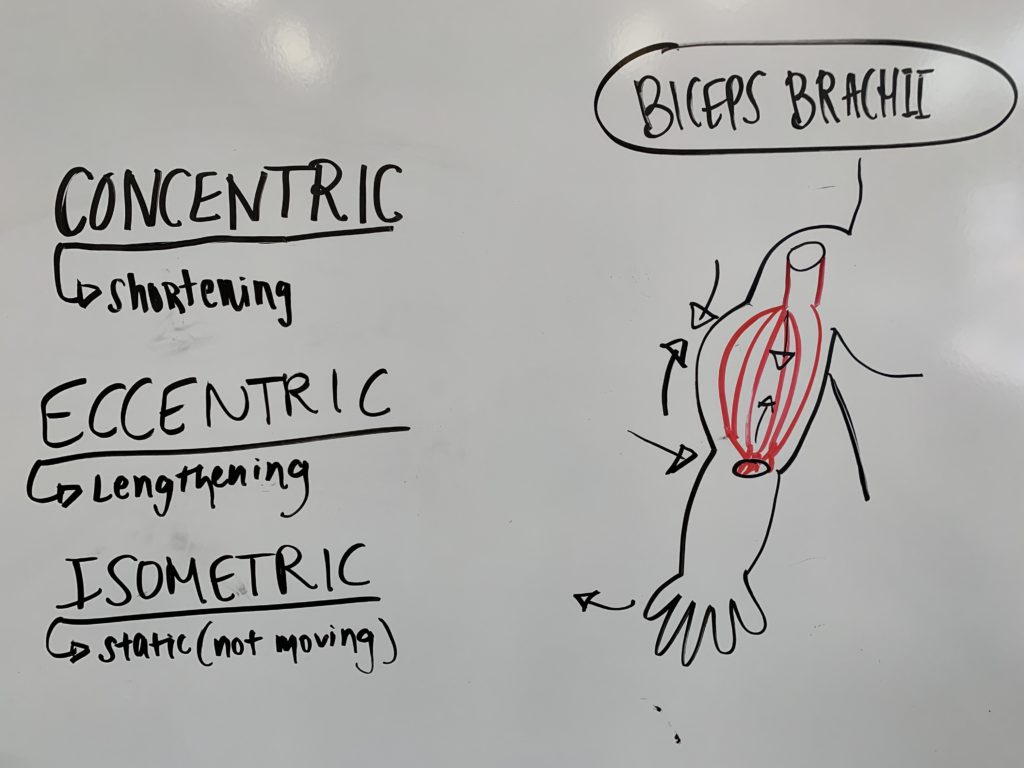
The 3 Categories of Exercise – Isometric, Concentric & Eccentric
Written by Tricia Moore
From eccentric to concentric to isometric, these are the fundamental building blocks of any holistic, full-body exercise program. Knowing the types of exercises available, and the benefits of each, help ensure you build both strength, and endurance. When you train, your muscles contract, and the way that they contract can be separated into three categories.
Types of Muscle Contractions
Isometric Contractions
An isometric exercise is any strength-training movement where your muscle length and the angle of your joints do NOT change. Examples include the plank and the side bridge, and bar hang. All three involve simply holding a key position with little to no movement. Other examples in our space often programmed are:
- Handstand hold
- High plank
- Wall sit
- Hollow hold
- Hanging from the pull-up bar
- Front rack kettlebell hold
What are the benefits of isometric exercises?
One of the greatest advantages of isometric contractions is holding still requires you to really engage your core ( bracing). Isometrics can be used to increase balance and body control, and allow participants to explore and feel the proper position.
Isometrics can also help you break through a strength plateau. For example, we tend to be weaker at our end ranges of motion.Think about a heavy back squat for example: pushing the weight up from the very bottom, or the “hole” is typically where most folks struggle. But sitting in the bottom of your squat with a weighted barbell on your back can help you develop the strength you need to stand the weight back up. The same concept applies to the push-ups or bench press. Holding your body an inch or two above the ground during a push-up, will help make the entire movement easier. What this does is place more of a focused emphasis on the muscle, helping to boost muscle growth.
Isometrics and Injury Recovery
Another fantastic application of isometric work can be seen during injury rehabilitation. And, sometimes isometric work is the preferred method many physical therapists utilize to get their clients back on track.
Benefits of Isometric Exercises for Injury Rehabilitation
There are many benefits to using isometric exercise after injury or surgery. These may include:
- You can safely contract a muscle while protecting a surgical incision or sensitive area.
- Your muscle can be strengthened in a very specific range of motion around a joint. This may assist with proper joint movement during rehab, or resetting or repatterning a movement after injury.
- No special equipment is necessary to perform isometric exercises.
- To help increase activation and input to a specific muscle.
EccentricContractions
An eccentric contraction is also known as a lengthening contraction. This kicks in when your muscles are elongated.
What are the benefits of eccentric exercises?
A common example can be seen during a bicep curl. The eccentric part of the movement is while you’re lowering the dumbbell downward slowly and with control. To really emphasize this part of the workout, you can prolong this part of the movement and keep the downward flow smooth and drawn out. We frequently use “tempo” prescriptions to emphasize this in our programs.
Eccentric contractions strengthen your muscle fibers, making it one of the most effective parts of the exercise to specifically stimulate growth in size. However, Eccentric training places a greater demand on your muscles and central nervous system, and may take longer to recover from it.
NOTE** Eccentrics damage your muscle more than concentric movements do. In addition to strengthening your muscles, eccentric training helps strengthen your tendons and ligaments, which decreases your risk of injury.
Examples of eccentric training include:
- Slowly bringing the barbell back down to the floor during a deadlift on a count of four
- Lowering yourself from a pull-up bar VERY SLOWLY i.e. doing “negatives”
Concentric Contractions
Think of a concentric exercise simply as the opposite of an eccentric movement. In a bicep curl, it’s the portion of the workout where you’re raising the dumbbell up towards you.
Other common concentric movements include:
- Lifting an object off the ground – first half of a deadlift
- Pressing to the top in a push-up
- Standing up during a squat
- Upward motion of a pull-up
What are the benefits of concentric exercises?
Whereas eccentric exercises stimulate size, concentric exercises stimulate strength. This makes them especially key for endurance, fighting fatigue, and improving performance in movements like running or swimming.
To focus on the concentric exercise, you may spend more time in the part of the workout where you’re raising or shortening your muscle, and less time on the eccentric portion of the movement, this lends itself to increased power, speed, and strength. However, this portion doesn’t strengthen the muscles as much as the eccentric portion of a lift does.
It’s helpful to understand that in order for a muscle to get stronger, you actually need to damage the muscle. You need to create microtears in the muscle that the body repairs and rebuilds even stronger than before, Concentric movements don’t damage the muscle as much eccentric movements do. While this means less strength gains per rep, it also means less soreness, and faster recovery.
By combining all three styles, and mixing up the emphasis that you place on your muscles, you can see the fastest, most dramatic results out of your everyday workout.
Then I do palates three times a week.
I do isometrics twice a week.
My name is Elesi Ameko.
Amazing information providing by your article, thank you so much for taking the time to share a wonderful article.